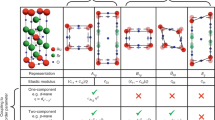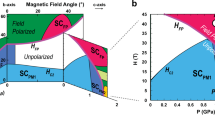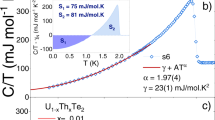Abstract
The microscopic mechanism of Cooper pairing in a superconductor leaves its fingerprint on the symmetry of the order parameter. UTe2 has previously been inferred to have a multi-component order parameter, in part due to the apparent presence of a two-step superconducting transition in some samples. However, recent experimental observations in newer-generation samples have raised questions about this interpretation, pointing to the need for a direct probe of the order parameter symmetry. Here we use pulse-echo ultrasound to measure the elastic moduli of UTe2 in samples that exhibit both one and two superconducting transitions. We demonstrate the absence of thermodynamic discontinuities in the shear elastic moduli of both single- and double-transition samples, providing direct evidence that UTe2 has a single-component superconducting order parameter. We further show that superconductivity is highly sensitive to compression strain along the a and c axes but insensitive to strain along the b axis. This leads us to suggest a single-component, odd-parity order parameter—specifically the B2u order parameter—as most compatible with our data.
This is a preview of subscription content, access via your institution
Access options
Access Nature and 54 other Nature Portfolio journals
Get Nature+, our best-value online-access subscription
$29.99 / 30 days
cancel any time
Subscribe to this journal
Receive 12 print issues and online access
$209.00 per year
only $17.42 per issue
Buy this article
- Purchase on Springer Link
- Instant access to full article PDF
Prices may be subject to local taxes which are calculated during checkout





Similar content being viewed by others
Data availability
Data that support the plots within this paper and other findings of this study are available via GitHub at https://github.com/CHiLL-Ramshaw/manuscripts-supporting_data/tree/0292ab9b15b60af93341e64b759507e4e59eb7cd/2024_Single_Component_Superconductivity_in_UTe2_at_Ambient_Pressure (ref. 44) and from the corresponding author upon reasonable request. Source data are provided with this paper.
References
Tsuei, C. C. & Kirtley, J. R. Pairing symmetry in cuprate superconductors. Rev. Mod. Phys. 72, 969–1016 (2000).
Ghosh, S. et al. Thermodynamic evidence for a two-component superconducting order parameter in Sr2RuO4. Nat. Phys. 17, 199–204 (2021).
Rice, T. M. & Sigrist, M. Sr2RuO4: an electronic analogue of 3He? J. Phys. Condensed Matter 7, L643–L648 (1995).
Mackenzie, A. P., Scaffidi, T., Hicks, C. W. & Maeno, Y. Even odder after twenty-three years: the superconducting order parameter puzzle of Sr2RuO4. npj Quantum Mater. 2, 40 (2017).
Sato, M. & Ando, Y. Topological superconductors: a review. Rep. Prog. Phys. 80, 076501 (2017).
Metz, T. et al. Point-node gap structure of the spin-triplet superconductor UTe2. Phys. Rev. B 100, 220504 (2019).
Ran, S. et al. Nearly ferromagnetic spin-triplet superconductivity. Science 365, 684–687 (2019).
Ishihara, K. et al. Chiral superconductivity in UTe2 probed by anisotropic low-energy excitations. Nat. Commun. 14, 2966 (2023).
Kittaka, S. et al. Orientation of point nodes and nonunitary triplet pairing tuned by the easy-axis magnetization in UTe2. Phys. Rev. Res. 2, 032014 (2020).
Aoki, D. et al. Unconventional superconductivity in heavy fermion UTe2. J. Phys. Soc. Jpn 88, 043702 (2019).
Ran, S. et al. Extreme magnetic field-boosted superconductivity. Nat. Phys. 15, 1250–1254 (2019).
Hayes, I. M. et al. Multicomponent superconducting order parameter in UTe2. Science 373, 797–801 (2021).
Wei, D. S. et al. Interplay between magnetism and superconductivity in UTe2. Phys. Rev. B 105, 024521 (2022).
Jiao, L. et al. Chiral superconductivity in heavy-fermion metal UTe2. Nature 579, 523–527 (2020).
Bae, S. et al. Anomalous normal fluid response in a chiral superconductor UTe2. Nat. Commun. 12, 2644 (2021).
Rosa, PriscilaF. S. et al. Single thermodynamic transition at 2 K in superconducting UTe2 single crystals. Commun. Mater. 3, 1–6 (2022).
Thomas, S. M. et al. Spatially inhomogeneous superconductivity in UTe2. Phys. Rev. B 104, 224501 (2021).
Aoki, D. et al. Multiple superconducting phases and unusual enhancement of the upper critical field in UTe2. J. Phys. Soc. Jpn 89, 053705 (2020).
Braithwaite, D. et al. Multiple superconducting phases in a nearly ferromagnetic system. Commun. Phys. 2, 147 (2019).
Ushida, K. et al. Lattice instability of UTe2 studied by ultrasonic measurements. JPS Conf. Proc. 38, 011021 (2023).
Rehwald, W. The study of structural phase transitions by means of ultrasonic experiments. Adv. Phys. 22, 721–755 (1973).
Shishidou, T., Suh, HanGyeol, Brydon, P. M. R., Weinert, M. & Agterberg, D. F. Topological band and superconductivity in UTe2. Phys. Rev. B 103, 104504 (2021).
Choi, H. C., Lee, S. H., & Yang, B.-J. Correlated normal state fermiology and topological superconductivity in UTe2. Preprint at https://arxiv.org/abs/2206.04876 (2023).
Shaffer, D. & Chichinadze, D. V. Chiral superconductivity in UTe2 via emergent C4 symmetry and spin-orbit coupling. Phys. Rev. B 106, 014502 (2022).
Sundar, S. et al. Ubiquitous spin freezing in the superconducting state of UTe2. Commun. Phys. 6, 24–34 (2023).
Girod, Clément et al. Thermodynamic and electrical transport properties of UTe2 under uniaxial stress. Phys. Rev. B 106, L121101 (2022).
Eaton, A. G. et al. Quasi-2D Fermi surface in the anomalous superconductor UTe2. Nat. Commun. 15, 223 (2024).
Aoki, D. et al. First observation of the de Haas–van Alphen effect and Fermi surfaces in the unconventional superconductor UTe2. J. Phys. Soc. Jpn 91, 083704 (2022).
Broyles, C. et al. Revealing a 3D Fermi surface pocket and electron-hole tunneling in UTe2 with quantum oscillations. Phys. Rev. Lett. 131, 036501 (2023).
Matsumura, H. et al. Large reduction in the a-axis Knight shift on UTe2 with Tc = 2.1 K. J. Phys. Soc. Jpn 92, 063701 (2023).
Iguchi, Y. et al. Microscopic imaging homogeneous and single phase superfluid density in UTe2. Phys. Rev. Lett. 130, 196003 (2023).
Xu, Y., Sheng, Y. & Yang, Yi-feng Quasi-two-dimensional Fermi surfaces and unitary spin-triplet pairing in the heavy fermion superconductor UTe2. Phys. Rev. Lett. 123, 217002 (2019).
Fujibayashi, H. et al. Superconducting order parameter in UTe2 determined by Knight shift measurement. J. Phys. Soc. Jpn 91, 043705 (2022).
Nakamine, G. et al. Anisotropic response of spin susceptibility in the superconducting state of UTe2 probed with 125Te-NMR measurement. Phys. Rev. B 103, L100503 (2021).
Nakamine, G. et al. Inhomogeneous superconducting state probed by 125Te NMR on UTe2. J. Phys. Soc. Jpn 90, 064709 (2021).
Machida, K. Theory of spin-polarized superconductors—an analogue of superfluid 3He A-phase. J. Phys. Soc. Jpn 89, 033702 (2020).
Machida, K. Nonunitary triplet superconductivity tuned by field-controlled magnetization: URhGe, UCoGe, and UTe2. Phys. Rev. B 104, 014514 (2021).
Nevidomskyy, A. H. Stability of a nonunitary triplet pairing on the border of magnetism in UTe2. Preprint at https://arxiv.org/abs/2001.02699 (2020).
Ishizuka, J., Sumita, S., Daido, A. & Yanase, Y. Insulator–metal transition and topological superconductivity in UTe2 from a first-principles calculation. Phys. Rev. Lett. 123, 217001 (2019).
Hazra, T. & Volkov, P. Pair-Kondo effect: a mechanism for time-reversal broken superconductivity and finite-momentum pairing in UTe2. Preprint at https://arxiv.org/abs/2210.16293 (2022).
Chang, Y.-Y. et al. Topological Kondo superconductors. Preprint at https://arxiv.org/abs/2301.00538 (2023).
Ran, S. et al. Comparison of two different synthesis methods of single crystals of superconducting uranium ditelluride. J. Vis. Exp. https://doi.org/10.3791/62563 (2021).
Theuss, F. et al. Resonant ultrasound spectroscopy for irregularly shaped samples and its application to uranium ditelluride. Phys. Rev. Lett. 132, 066003 (2024).
Theuss, et al. 2024_single_component_superconductivity_in_UTe2_at_ambient_pressure. GitHub https://github.com/CHiLL-Ramshaw/manuscripts-supporting_data/tree/0292ab9b15b60af93341e64b759507e4e59eb7cd/2024_Single_Component_Superconductivity_in_UTe2_at_Ambient_Pressure (2024).
Acknowledgements
We acknowledge helpful discussions with D. Agterberg and P. Brydon. We thank the Cornell LASSP Professional Machine Shop for their contributions to designing and fabricating equipment used in this study. A. Shragai, B.J.R. and F.T. acknowledge funding from the Office of Basic Energy Sciences of the United States Department of Energy under award number DE-SC0020143 (ultrasound experiments and analysis). N.P.B. and J.P. acknowledge support from the Department of Energy award number DE-SC-0019154 (sample characterization), the Gordon and Betty Moore Foundation’s EPiQS Initiative through grant number GBMF9071 (materials synthesis), the National Science Foundation under grant number DMR-2105191 (sample preparation) and the Maryland Quantum Materials Center and the National Institute of Standards and Technology. B.J.R. and F.T. acknowledge use of the Cornell Center for Materials Research Shared Facilities which are supported through the NSF MRSEC programme (DMR-1719875). G.G. acknowledges support from the ANR grants STeP2 no ANR-22-EXES-0013 and QuantEx no ANR-23-CE30-0001-01.
Author information
Authors and Affiliations
Contributions
B.J.R. conceived the experiment. I.M.H., S.R.S., Y.S.E. and A. Suarez grew and characterized the samples. F.T. and A. Shragai performed the sample preparation and transducer fabrication. F.T., A. Shragai and G.G. performed the ultrasound measurements. F.T. and B.J.R. performed the data analysis and mean-field calculations. T.S. performed density functional theory calculations. F.T. and B.J.R. wrote the paper with input from all other co-authors. J.P., N.P.B. and B.J.R. supervised the project.
Corresponding author
Ethics declarations
Competing interests
The authors declare no competing interests.
Peer review
Peer review information
Nature Physics thanks Tatsuya Yanagisawa and the other, anonymous, reviewer(s) for their contribution to the peer review of this work.
Additional information
Publisher’s note Springer Nature remains neutral with regard to jurisdictional claims in published maps and institutional affiliations.
Extended data
Extended Data Fig. 1 Raw Pulse-Echo Signal.
The raw signal from a sputtered ZnO shear transducer on sample S3 with sound propagation along the [010] and polarization along the [100] directions. The transducer exhibits both a compressional (blue lines) and a shear (red dashed lines) response. These correspond to sound modes determined by the elastic moduli c22 and c66, respectively.
Extended Data Fig. 2 Comparison of different transducers.
Shown are Δc33/c33 for single Tc (S1, left) and two Tc (S3, right) samples. For each sample we compare the relative change in elastic modulus between measurements obtained with two different transducers. Both transducers excited sound along the [001] direction. However, for the data in red, the shear component of the transducer was polarized along [100] (additionally measuring c55), whereas for the data in blue, the shear component of the transducer was polarized along [010] (additionally measuring c44).
Supplementary information
Supplementary Information
Supplementary Figs. 1–11, Discussion and Tables 1–3.
Source data
Source Data Fig. 2
Delta c/c for samples with one superconducting transition.
Source Data Fig. 3
Delta c/c for samples with one and two superconducting transitions.
Source Data Fig. 4
Delta c/c for compressional elastic moduli.
Rights and permissions
Springer Nature or its licensor (e.g. a society or other partner) holds exclusive rights to this article under a publishing agreement with the author(s) or other rightsholder(s); author self-archiving of the accepted manuscript version of this article is solely governed by the terms of such publishing agreement and applicable law.
About this article
Cite this article
Theuss, F., Shragai, A., Grissonnanche, G. et al. Single-component superconductivity in UTe2 at ambient pressure. Nat. Phys. (2024). https://doi.org/10.1038/s41567-024-02493-1
Received:
Accepted:
Published:
DOI: https://doi.org/10.1038/s41567-024-02493-1
This article is cited by
-
Elastic response reveals the pairing symmetry
Nature Physics (2024)



